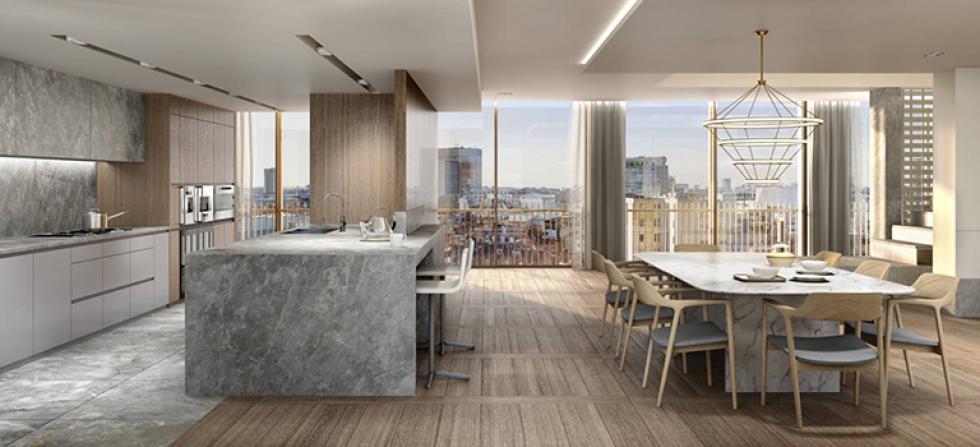

We're all familiar with what a chair should look like, how a curtain should fall, or what a throw might look like if it were draped over a sofa, because we see these things everyday as part of the fabric of our own homes. Because of that instinctive familiarity, it's no easy challenge to produce interior CG images that feel real and faithfully replicate the reality of a space, particularly a luxurious duplex apartment that does not yet exist, as with Fitzroy Place. However, this is what we do!
When you think of 'home' you don't necessarily think about a specific room or piece of furniture, but rather how the space makes you feel. It is that instinctive emotional connection that people have with their environments that we look to invoke in our imagery. A home can at times be a place to relax, or a cocoon from the outside world, yet can be adapted to create a social and stimulating place to share with others. Maintaining a balance between the different characteristics people want from a home is essential to making an image accessible.

When it came to approaching Fitzroy Place, for me it was important that our imagery properly translated the interior of the apartment, whilst conveying the emotive qualities that we all individually associate with 'home'. It was essential that we represented the design accurately, and that all the materials, fixtures and fittings were correct; these finishes are what help to create the whole look and feel of a space, and subconsciously are the physical characteristics we identify with the most.
“Texture provides depth and richness to a surface that appeals to our natural instinct to touch.”
Space designed with order, functionality, and proportion in mind does not on its own make a place that connects with us emotively. To be an engaging environment, a space needs to provoke and stimulate the senses, which is why the use of materials and texture play an important role to enrich our response to our immediate surroundings. Natural, high quality materials are not just visually alluring, but possess their own unique textures that subtly affect how we react to them. Texture provides depth and richness to a surface that appeals to our natural instinct 'to touch'.
Coarse textures tend to appear hard and heavy because light cannot travel undisturbed across a rough surface; this gives the visual illusion of something more dense and solid in form. In contrast smooth and more reflective textures appear to feel lighter and softer in form. To understand how we respond to texture is important and can be the crucial element to the design, as it can transform the entire mood and atmosphere of an interior. Soft, raised textures convey the sense of warmth and comfort; a characteristic we tend to associate with home. It is this basic principle that we looked to explore with more detail in our imagery for Fitzroy Place. Fabric and the layering of soft furnishing is a key component to help a space feel comfortable and relaxing; the use of soft accessories encourages and persuades us to sit back and enjoy the intimacy of the space.

Throughout the scheme there is a beautiful balance of materials and textures, used continually within the design and fitout of the apartment. We looked to replicate and exploit this in 3D to help the images really come to life. The living room shot combines a mixture of the hard and soft elements that furnish the space, contrasting in texture and density, yet working harmoniously together. The raw, cut stone coffee table centred in the middle of the space and juxtaposed between two large, sumptuous sofas adds a level of drama and tension. Despite this bold interruption, the space maintains the feeling of comfort and warmth around the centre piece. The key to this balance was to capture the warmth of the fire and the soft luxuriousness of the sofas, dressed casually with a couple of cushions and a throw to soften and enhance the allure of the space.

All of these features may perhaps appear quite effortless and chic, but have been carefully thought through and constructed with detail to capture that 'instinctive familiarity', and create the feeling of a tangible space that you could almost imagine to be real. For me it is crucial that the visual effect of an image is not diluted by the medium that it was created in. It can be easy to spot when an image is CG, but when technology is continually evolving these boundaries are slowing beginning to blur. It becomes exciting when you begin to question if the image is in fact real!
Jane Chambers
07 February 2014